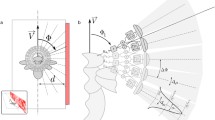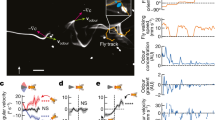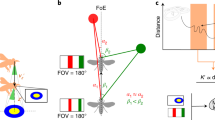Abstract
We develop a method that allows a flyer to estimate its own motion (egomotion), the wind velocity, ground slope, and flight height using only inputs from onboard optic flow and air velocity sensors. Our artificial algorithm demonstrates how it could be possible for flying insects to determine their absolute egomotion using their available sensors, namely their eyes and wind sensitive hairs and antennae. Although many behaviors can be performed by only knowing the direction of travel, behavioral experiments indicate that odor tracking insects are able to estimate the wind direction and control their absolute egomotion (i.e., groundspeed). The egomotion estimation method that we have developed, which we call the opto-aeronautic algorithm, is tested in a variety of wind and ground slope conditions using a video recorded flight of a moth tracking a pheromone plume. Over all test cases that we examined, the algorithm achieved a mean absolute error in height of 7% or less. Furthermore, our algorithm is suitable for the navigation of aerial vehicles in environments where signals from the Global Positioning System are unavailable.
Similar content being viewed by others
References
Bab-Hadiashar A, Suter D, Jarvis R (1995) Image-interpolation based optic flow technique. In: Proceedings of the SPIE conference on applications of digital image processing XVIII, pp 271–281
Bailey JK (2004) A multi-sensory robot for locating the source of wind-borne chemicals. Thesis, Case Western Reserve University
Barron JL, Fleet DJ, Beauchemin SS (1994) Performance of optical flow techniques. Int J Comput Vis 12: 43–77
Barrows GL, Chahl JS, Srinivasan MV (2003) Biologically inspired visual sensing and flight control. Aeronaut J 107: 159–168
Budick SA, Reiser MB, Dickinson MH (2007) The role of visual and mechanosensory cues in structuring forward flight in Drosophila melanogaster. J Exp Biol 210: 4092–4103
Çelik K, Chung S-J, Clausman M, Somani A (2009) Biologically inspired monocular vision based navigation and mapping in GPS-denied environments. In: Proceedings of the AIAA infotech@Aerospace conference, pp 1–17
Comeaux J (1983) Air navigation. Air Force Man 51–40
Conroy J, Gremillion G, Ranganathan B, Humbert JS (2009) Implementation of wide-field integration of optic flow for autonomous quadrotor navigation. Auton Robot 27: 189–198
Dahmen HJ, Franz MO, Krapp HG (2001) Extracting egomotion from optic flow: limits of accuracy and neural matched filters. In: Zanker JM, Zeil J (eds) Motion vision—computational, neural, and ecological constraints. Springer Verlag, Berlin, pp 143–168
David CT (1986) Mechanisms of directional flight in wind. In: Payne TL, Birch MC, Kennedy CEJ (eds) Mechanisms in insect olfaction. Clarendon Press, New York, pp 49–57
Fadamiro HY, Wyatt TD, Birch MC (1998) Flying beetles respond as moths predict: optomotor anemotaxis to pheromone plumes at different heights. J Insect Behav 11: 549–556
Foster SP, Howard AJ (1999) The effects of source dosage, flight altitude, wind speed, and ground pattern on the sex pheromone-mediated flight manoeuvres of male lightbrown apple moth, Epiphyas postvittana (Walker). New Zeal J of Zool 26: 97–104
Franz MO, Chahl JS, Krapp HG (2004) Insect-inspired estimation of egomotion. Neural Comput 16: 2245–2260
Garratt MA, Chahl JS (2008) Vision-based terrain following for an unmanned rotorcraft. J Field Robot 25: 284–301
Gewecke M (1974) The antennae of insects as air-current sense organs and their relationship to the control of flight. In: Browne LB (eds) Experimental analysis of insect behavior. Springer-Verlag, Berlin, pp 100–113
Griffiths S, Saunders J, Curtis A, Barber DB, McLain TW, Beard RB (2006) Maximizing miniature aerial vehicles. IEEE Robot Autom Mag 13: 34–43
Kennedy JS (1940) The visual responses of flying mosquitoes. Proc Zool Soc Lond A 109: 221–242
Kennedy JS, Marsh D (1974) Pheromone regulated anemotaxis in flying moths. Science 184: 999–1001
Koenderink JJ, van Doorn AJ (1987) Facts on optic flow. Biol Cyber 56: 247–254
Kuenen LPS, Baker TC (1982) Optomotor regulation of ground velocity in moths during flight to sex pheromone at different heights. Physiol Entomol 7: 193–202
Lanczos C (1988) Applied analysis. Dover Publications, New York
Liu C (2007) Micromachined biomimetic artificial haircell sensors. Bioinsp Biomim 2: S162–S169
Ludlow AR (1984) Application of computer modelling to behavioral coordination. Dissertation, University of London
Marsh D, Kennedy JS, Ludlow AR (1978) An analysis of anemotactic zigzagging flight in male moths stimulated by pheromone. Physiol Entomol 3: 221–240
Miao AX, Zacharias GL, Warren R (1996) Passive navigation from image sequences—a practitioner’s approach. In: Proceedings of the AIAA flight simulation technologies conference, pp 726–740
Nagle MG, Srinivasan MV (1996) Structure from motion: determining the range and orientation of surfaces by image interpolation. J Opt Soc Am A 13: 25–34
Nagle MG, Srinivasan MV, Wilson DL (1997) Image interpolation technique for measurement of egomotion in 6 degrees of freedom. J Opt Soc Am A 14: 3233–3241
Pringle JWS (1948) The gyroscopic mechanism ofS the halteres of Diptera. Philos T Roy Soc B 233: 347–384
Rayner JMV, Aldridge HDJN (1985) Three-dimensional reconstruction of animal flight paths and the turning flight of microchiropteran bats. J Exp Biol 118: 247–265
Reina T (1998) Source code for Matlab 5.1 MEX interface for GCVSPL. http://isbweb.org/c/isb/pub/files/orig_website/software/sigproc/gcvspl/reina/source.html
Ruffier E, Franceschini N (2004) Visually guided micro-aerial vehicle: automatic take off, terrain following, landing and wind reaction. In: Proceedings of the 2004 IEEE international conference on fobotics and automation, pp 2339–2346
Sane SP, Dieudonné A, Willis MA, Daniel TL (2007) Antennal mechanosensors mediate flight control in moths. Science 315: 863–866
Srinivasan MV (1994) An image-interpolation technique for the computation of optical flow and egomotion. Biol Cybern 71: 401–415
Srinivasan MV, Poteser M, Kral K (1999) Motion detection in insect orientation and navigation. Vision Res 39: 2749–2766
Taylor G, Krapp HG (2008) Sensory systems and flight stability: What do insects measure and why?. In: Casas J, Simpson SJ (eds) Advances in insect physiology 34. Academic Press, Diego, pp 231–316
Toupet, O, Paduano, JD, Panish, R, Sedwick, R, Frazzoli, E. Augmenting state estimates with multiple camera visual measurements. In: Proceedings of the AIAA infotech@Aerospace conference and exhibit
Willis MA, Arbas EA (1991) Odor-modulated upwind flight of the sphinx moth, Manduca sexta L. J Comp Physiol A 169: 427–440
Willis MA, Arbas EA (1998) Variability in odor-modulated flight by moths. J Comp Physiol A 182: 191–202
Woltring HJ (1986) A FORTRAN package for generalized, cross-validatory spline smoothing and differentiation. Adv Eng Softw 8: 104–113
Zanen PO, Cardé RT (1996) Effects of host-odour plume altitude and changing wind velocity on upwind flight manoeuvres of a specialist braconid parasitoid. Physiol Entomol 21: 329–338
Zufferey J-C, Floreano D (2005) Toward 30-gram autonomous indoor aircraft: vision-based obstacle avoidance and altitude control. In: Proceedings of the 2005 IEEE international conference on robotics and automation, Barcelona, pp 2594–2599
Author information
Authors and Affiliations
Corresponding author
Rights and permissions
About this article
Cite this article
Rutkowski, A.J., Miller, M.M., Quinn, R.D. et al. Egomotion estimation with optic flow and air velocity sensors. Biol Cybern 104, 351–367 (2011). https://doi.org/10.1007/s00422-011-0440-z
Received:
Accepted:
Published:
Issue Date:
DOI: https://doi.org/10.1007/s00422-011-0440-z




